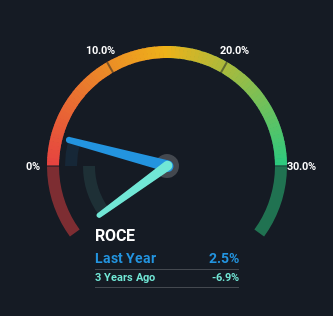Capital Allocation Trends At Ermes Department Stores (CSE:ERME) Aren't Ideal
If you're not sure where to start when looking for the next multi-bagger, there are a few key trends you should keep an eye out for. In a perfect world, we'd like to see a company investing more capital into its business and ideally the returns earned from that capital are also increasing. Put simply, these types of businesses are compounding machines, meaning they are continually reinvesting their earnings at ever-higher rates of return. Having said that, from a first glance at Ermes Department Stores (CSE:ERME) we aren't jumping out of our chairs at how returns are trending, but let's have a deeper look.
What Is Return On Capital Employed (ROCE)?
If you haven't worked with ROCE before, it measures the 'return' (pre-tax profit) a company generates from capital employed in its business. Analysts use this formula to calculate it for Ermes Department Stores:
Return on Capital Employed = Earnings Before Interest and Tax (EBIT) ÷ (Total Assets - Current Liabilities)
0.025 = €2.5m ÷ (€179m - €79m) (Based on the trailing twelve months to June 2023).
So, Ermes Department Stores has an ROCE of 2.5%. In absolute terms, that's a low return and it also under-performs the Multiline Retail industry average of 6.4%.
See our latest analysis for Ermes Department Stores

Historical performance is a great place to start when researching a stock so above you can see the gauge for Ermes Department Stores' ROCE against it's prior returns. If you're interested in investigating Ermes Department Stores' past further, check out this free graph covering Ermes Department Stores' past earnings, revenue and cash flow.
What The Trend Of ROCE Can Tell Us
In terms of Ermes Department Stores' historical ROCE movements, the trend isn't fantastic. Over the last five years, returns on capital have decreased to 2.5% from 3.9% five years ago. Although, given both revenue and the amount of assets employed in the business have increased, it could suggest the company is investing in growth, and the extra capital has led to a short-term reduction in ROCE. And if the increased capital generates additional returns, the business, and thus shareholders, will benefit in the long run.
On a related note, Ermes Department Stores has decreased its current liabilities to 44% of total assets. So we could link some of this to the decrease in ROCE. Effectively this means their suppliers or short-term creditors are funding less of the business, which reduces some elements of risk. Some would claim this reduces the business' efficiency at generating ROCE since it is now funding more of the operations with its own money. Keep in mind 44% is still pretty high, so those risks are still somewhat prevalent.
The Bottom Line
Even though returns on capital have fallen in the short term, we find it promising that revenue and capital employed have both increased for Ermes Department Stores. And there could be an opportunity here if other metrics look good too, because the stock has declined 53% in the last five years. As a result, we'd recommend researching this stock further to uncover what other fundamentals of the business can show us.
Like most companies, Ermes Department Stores does come with some risks, and we've found 3 warning signs that you should be aware of.
While Ermes Department Stores may not currently earn the highest returns, we've compiled a list of companies that currently earn more than 25% return on equity. Check out this free list here.
Valuation is complex, but we're here to simplify it.
Discover if Ermes Department Stores might be undervalued or overvalued with our detailed analysis, featuring fair value estimates, potential risks, dividends, insider trades, and its financial condition.
Access Free AnalysisHave feedback on this article? Concerned about the content? Get in touch with us directly. Alternatively, email editorial-team (at) simplywallst.com.
This article by Simply Wall St is general in nature. We provide commentary based on historical data and analyst forecasts only using an unbiased methodology and our articles are not intended to be financial advice. It does not constitute a recommendation to buy or sell any stock, and does not take account of your objectives, or your financial situation. We aim to bring you long-term focused analysis driven by fundamental data. Note that our analysis may not factor in the latest price-sensitive company announcements or qualitative material. Simply Wall St has no position in any stocks mentioned.
Have feedback on this article? Concerned about the content? Get in touch with us directly. Alternatively, email editorial-team@simplywallst.com
About CSE:ERME
Ermes Department Stores
Operates various departmental and other stores in Cyprus and Greece.
Good value with low risk.
Market Insights
Community Narratives




